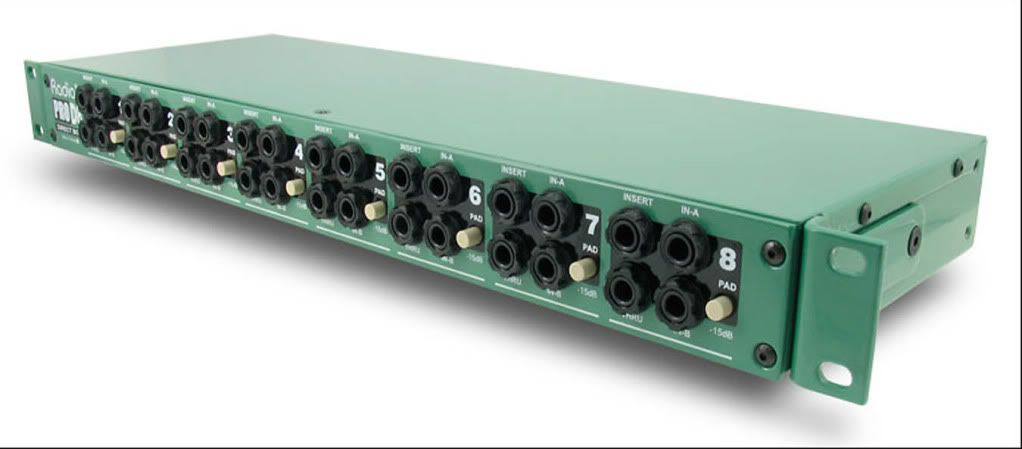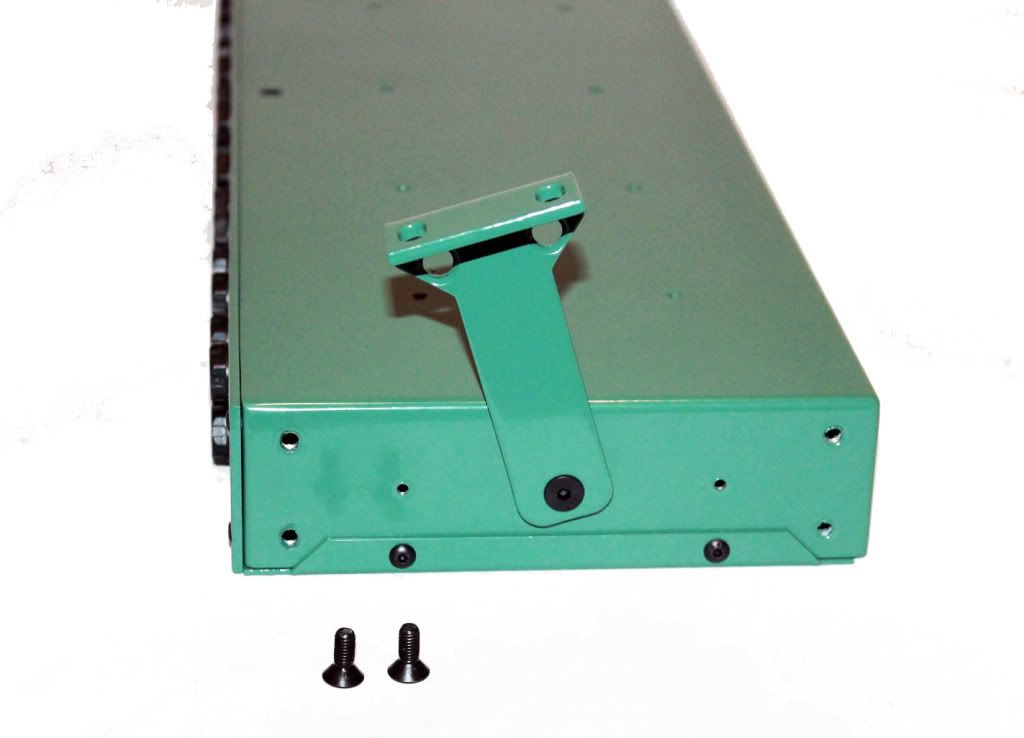
The Radial Engineering ProD8 is an 8-channel, rack-mountable passive direct box that is optimized for use with keyboards, but it has many other uses at gigs as well. The eight channels can each be used with mono sources, or with stereo sources that it can merge to mono. The unit also offers loop-through routing capabilities, as well as an effects loop on every channel.
Like all Radial units I’ve worked with over the years, the ProD8 is very well built. The outer chassis is constructed of 14-gauge steel, covered with a baked enamel finish. It measures 1RU high by 6.2 inches deep, and weighs about 8 pounds. Frequency response is specified as 20 Hz to 18.5 kHz (+ or - 0.2 dB) with total harmonic distortion at 0.01 percent from 20 Hz to 20 kHz (-10 dB) Input impedance is stated as 140k Ohms (unbalanced), while output impedance is 150 Ohms (balanced). Each channel uses a shielded Eclipse ET-DB1 transformer with a 12:1 turn ratio.
The front panel offers 1/4-inch inputs and outputs, as well as PAD switches. For each channel there are two 1/4-inch jacks for inputs A and B that will auto merge to mono, a single 1/4-inch jack for loop-through output, and a TRS 1/4-inch jack for the effects loop. Each channel also has a -15 dB PAD switch to accommodate higher output devices.
On the rear panel, meanwhile, each channel has an XLR output, a ground-lift switch, and a polarity switch that reverses pins 2 and 3 on the XLR. Internally, there are individual channel switches for chassis ground set in the “lift” position at the factory. Also inside, pre/post switches allow the through output to be either pre or post the effects loop. (These are factory set to the post effects loop position.)
Earlier I referenced the front and rear of the unit, but it offers reversible (pivoting) rack ears so either can face the front of a rack. This is a great feature for those who are going to rack the unit with other gear and may want more convenient access to the XLRs to interconnect with the PA. Many of us in production, however, probably would choose to have the 1/4-inch connectors facing front so we can easily interface different setups, and then use a fan-to-fan XLR snake connected to the back for the hookup to the PA.

There are four different ways to use the ProD8:
1) For eight mono sources or keyboards. By plugging into just one of the A or B input jacks the unit behaves like eight separate mono DIs.
2) With eight mono keyboards. Plug a stereo signal or keyboard into the A and B inputs on a channel, and the ProD8 merges the signals to a mono output, and a mono “thru” output for onstage monitoring. This is a great feature to have if you have a limited number of snake or mixer channels available.
3) With four stereo sources or keyboards by simply using two channels in the ProD8 per keyboard. Of course you can always use any combination of stereo and mono sources together as each channel is fully isolated from the others.
4) With eight merged stereo keyboards. This requires splitting a keyboard’s outputs between two separate channels using the A input on one channel and the B input on a second channel. By using both inputs this way, two keyboards can share two channels and while they will be merged together, they will both output a stereo signal.

With eight DIs jammed into a single rack-space, the ProD8 offers a lot of possibilities for different connection configurations in a small package. Radial also includes an effects loop on each channel so one can use a TRS cable (similar to inserting an effects unit into a console channel) to interface an effects processor into the rig. This could be handy for a keyboard player, but I don’t see sound folks using the insert jack much, if at all.
Before taking any gear out on a gig, I plug it in at the shop to see what it can do. While setting up the Radial ProD8 for a test, I realized an additional use for the unit. On some corporate gigs, I run out of available stereo inputs on the small mixers that are standard for A/V companies. The ProD8 would be an ideal interface at front of house for the numerous stereo playback devices that are required, and could merge them into mono signals saving a few inputs.
To see if that idea would work, I plugged in an iPod as well as a CD player into the Radial and ran the output to a small powered mixer and speaker. The CD player seemed a little hot so I engaged the -15 dB PAD switch and got a clean signal. My iPad doesn’t have a very high output, so I ran it without the PAD and got great results. Both signals sounded clean and full sounding and all the information that was in the left and right channels seemed to be present in the merged mono signal.
Using a Korg Triton, I tested the ProD8’s channels in both mono and merged mono, and my fantastic keyboard playing left the guys in the warehouse next door wanting more. (More silence that is…) Using different synth patches and some piano and organ sounds, I compared stereo, mono, and stereo merge modes. With headphones from the mixer, the true stereo sounds were hard to beat, but the stereo merge sounded just as good on many patches and close enough for me on a few for me to forget which configuration I was listening to.
Assured that everything was working properly, I packed up the Pro8D with the gear I was staging for my next gig. This was a typical corporate show, with a few presenters using computer presentations with audio and some walk in music. While I had no real need to use the unit, I decided to set it up at FOH anyway and run my iPhone and iPad into it for the walk in/out music summed to mono. It worked like a charm, and I could see using it in this application if I ran out of stereo inputs at a show. A bonus was that I could choose between a 1/4-input or XLR output for each channel that I needed to merge to mono.
At the next gig, with a small jazz band. I used one channel for the bass guitar (a Fender Jazz) and two channels for a stereo hookup of a Yamaha Motif playing mostly piano and some organ sounds. With this small quartet, dropping a single multi-unit was just as easy as using multiple DIs as the bass player was set up next to the keyboardist. The Pro8D sounded great with both the bass and keyboards.
While I did run the keyboard in stereo, I would not have hesitated to hook up the keyboard into stereo merged mode if I had run out of channels in the mixer or snake. I didn’t use the “thru” jack for the keyboard player because she was happy just having the keyboard in a floor wedge, but I did run out of the ProD8 for the bass player and into his combo amp. The keys and the bass both sounded fine and we had a great show.
The third gig was with a large band whose keyboard player had two keyboards and a rack with two modules. He had a 4-channel DI already mounted in his rack, but I asked him if we could use the Pro8D instead, and he obliged. We ran the modules in mono, as he prefers, but ran the main keyboard in stereo and the other keyboard in stereo merge mode, instead of his usual mono. He really liked the merge feature, and was surprised that the unit packs eight channels into such a small footprint.
For an audio provider who works with a lot of musical artists, especially ones with a lot of keyboards or sound sources, the Pro8D is a perfect unit. It provides routing options, a great stereo merge to mono feature, and is built to handle the rigors of our business. In addition, it eliminates a bunch of loose DIs and cleans up stage cabling. U.S. MSRP for the ProD8 is $850.

